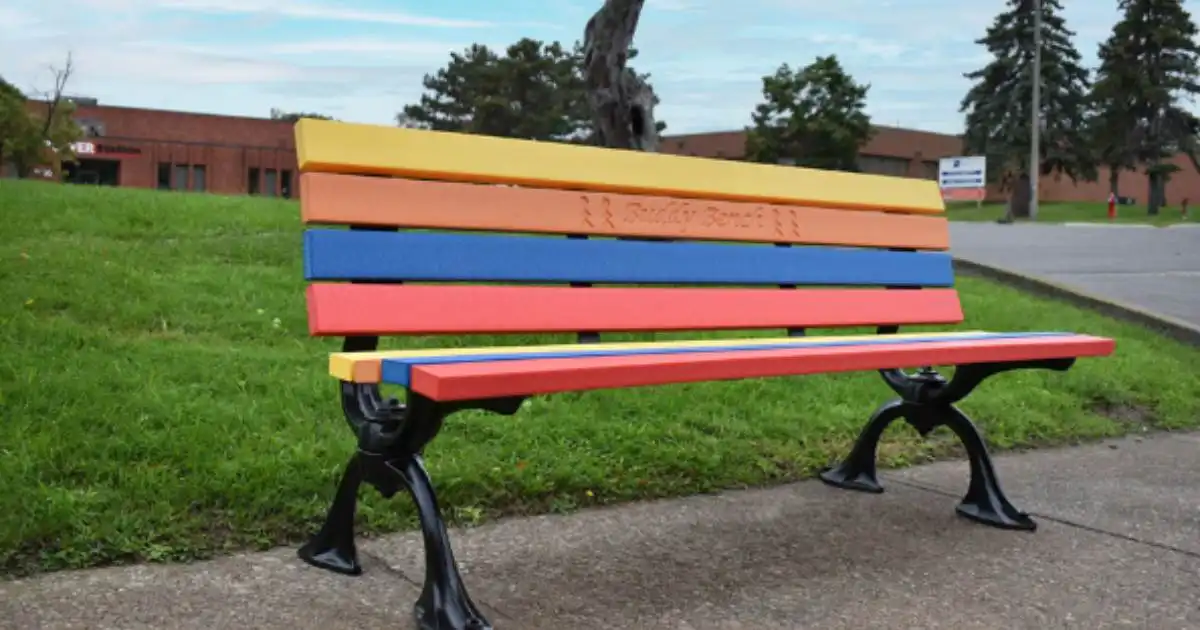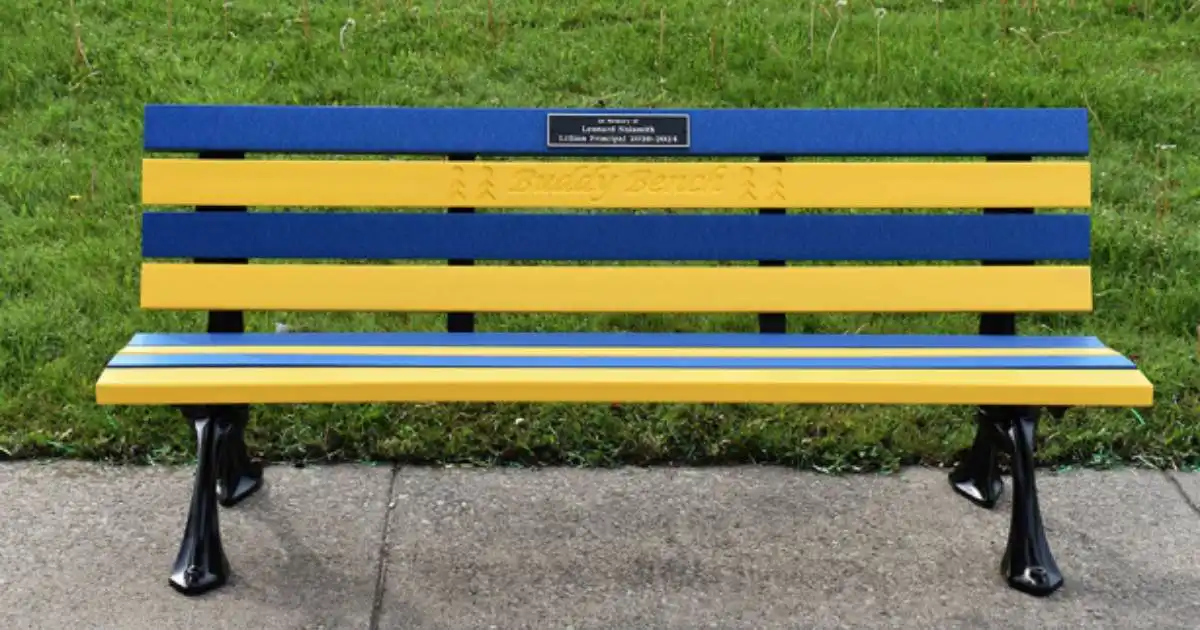
Making friends is wonderful, but it isn’t always easy, especially for young children. Growing up means learning to be social, but if your child struggles with being shy, or perhaps they’re being introduced to a new school, it can be daunting to approach new potential friends.
Luckily, there’s a solution to this problem that is not only effective, but practical!
It’s BUDDY BENCHES!
A buddy bench, also called a friendship bench, is an emerging trend in site furniture designed to bring kids together. When a child is having a hard time introducing themselves or making friends, they sit on the buddy bench, indicating they want a companion to play with. When another child sees someone on the buddy bench, they know they can approach them and ask them to come play.
Classic Displays aren’t just “hopping on a trend” here; we’re empowering youth to embrace one another and make lasting, formative friendships. Let’s explore the benefits of buddy benches together and how to get yours right!
Buddy benches aren’t just about helping kids to make friends; they’re also about making sure that nobody is left out. These benches ensure that children who feel lonely or isolated can indicate that they're looking for a kind soul to invite them into the fold. Using a buddy bench program on a playground can encourage students to look out for each other, ensuring no one feels like they're an outsider.
According to the National Library of Medicine, three studies on children and adolescents have proven that social isolation has a significant impact on both mental and physical health. Children with a reported high level of social isolation were more likely to become depressed adults, as well as being more likely to have a higher risk of cardiac inflammation and metabolic diseases such as obesity.
No parent wants their child to struggle to make connections with their peers; social development is essential to becoming a well-rounded adult. It allows children to bolster their social skills, build confidence, and find a sense of belonging.
But where do we fit buddy benches into these equations?
Buddy benches are designed to be the bridge between the gap of social isolation and genuine connection. They’re crafted to limit the social divide that often happens when children are introduced into new situations; such as changing schools, entering a new grade, or even just trying to find a solid group of friends.
Buddy benches are a softer, quieter way to let people know that a child wants to be included, without the fear of having to approach a group and potentially face social rejection.
But how do you make a buddy bench more welcoming? Well, by making it stylish and accessible, of course!
Classic Displays have several options for buddy benches, all of which are designed to be both beautiful and inclusive. Rather than having a simple, or frankly dull bench, you can have something colour and accessible for children of almost every physical capability.

Having a buddy bench is great, but, if you’ve read any of our blogs about site furniture, you’ll understand that strategic placement is also important. There’s no sense in investing in a buddy bench if you put it in a place where no one is going to reasonably use it.
So, how do you best place a buddy bench? We’re happy you asked.
1. Place the Bench Where Kids Gather: Putting a buddy bench where kids are likely to play ensures that there are plenty of opportunities for social interaction. Buddy benches are perfect in areas such as playgrounds, splash pads, near school entrances, or within sight of school supervisors. This way, you can ensure children are always capable of crossing paths and making meaningful connections.
2. Ensure a Lack of Obstructions: Not all kids are the same. Some of them have limitations, and that means that it’s absolutely essential to make sure that your buddy benches are accessible. This means making sure that children who need mobility devices or require some additional help can safely and comfortably interact with your buddy bench. Our Contour Bench is designed to be both beautiful and accessible, so you can trust that every kid can enjoy it.
3. Enforce Kind Practices: Buddy benches are great — but they still require supervision. The last thing you want is for a shy child to be ostracized or singled out for sitting on a buddy bench; that’s why you need to ensure a certain level of oversight. By making sure there is a responsible adult present to prevent potential bullying, you can make buddy benches a safe place. Once again, according to the National Library of Medicine, the influence of parenting has a significant impact on temperament and empathy development. Empathetic children are proven to thrive better in society, meaning enabling kindness promotes a happier, kinder world.
4. Make Sure the Bench is Properly Labeled & Recognizable: This isn’t a normal bench, it’s a buddy bench! That means it needs to stand out from other benches, otherwise, kiddos may not understand its intended purpose. Making a colourful, inviting bench with a clear label indicating that this special bench is, in fact, a buddy bench. Check out another version of our Riverside Buddy Bench:

Now, how do you make sure children use buddy benches as intended? On some forums, parents and concerned citizens have voiced their apprehension towards buddy benches, primarily because they fear it will draw attention to vulnerable kids, resulting in bullying.
Of course, while not all bullying can be completely prevented, proper education, conversation, and intervention can ensure that the buddy bench program is being used appropriately.
Contrary to the concerns, buddy benches were initially designed to PREVENT bullying. Christian Bucks, who popularized the concept of buddy benches in North America, got the idea when his family was considering a move to Germany. When he began to research local schools, he saw that there were special benches designed to help kids find playmates during recess. He was so inspired by the idea that he brought it to his principal, who embraced it fully.
Today, they’re used as an anti-bullying measure, encouraging children who struggle socially or face bullying to find supportive peers and companionship.
However, there are some additional steps that can be taken to ensure that buddy benches are a part of the solution, not the problem!
1. Send Out Pamphlets/Emails to Parents: Send written material to parents informing them about the buddy bench program, its intended purpose, and how to have constructive and supportive conversations with their kids about them. This way, parents can be a part of the preventative measures by having open conversations with their children to deter bullying and promote being kind to others.
2. Host Assemblies and Keep Staff Involved: It’s also important to introduce buddy benches to the entire school with staff fully involved. Buddy benches should be introduced as a positive means of making friendships and preventing bullying behaviour. However, staff also need to recognize the signs of misuse and address them as they happen.
3. Create Incentives: Adding incentives, such as a reward program, can promote positive use of buddy benches. An example could be something as simple as giving students tickets or gold stars for using buddy benches or playing with their peers who do. These tickets or stars can be redeemed for fun prizes, such as knick knacks or a pizza party for the class. This creates a positive associated with using buddy benches for the right reasons!
4. Monitor Effectively: Having outdoor volunteers or staff members present on the playground can ensure that bullying behaviour is being appropriately addressed and reprimanded. While it’s never ideal to have to result to punishment, it doesn’t have to consist solely of putting a kid in the corner. It can come with education or anti-bullying programs, which have been shown to have a positive impact. Oftentimes, children who partake in bullying behaviour are facing their own challenges, meaning strict punishments may not be as effective. However, direct and swift intervention is often required, especially if bullying becomes severe. In which case, harsher action is often necessary.
Some signs to recognize when identifying bullies and children being bullied include:
Frequent name-calling, teasing, or mocking others.
Aggressive behaviour toward peers, siblings, or even adults.
Dominates games or activities and insists on always being in control.
Lacks empathy or minimizes others’ feelings.
Blames others for their problems or refuses to take responsibility.
Get into physical or verbal fights often.
Has friends who bully others or encourage others to be mean.
Gets in trouble at school for discipline issues or disrespect.
Shows little remorse when someone is hurt or upset.
Boasts about popularity, power, or making others feel small.
Uses social media to gossip, exclude, or harass (in older children).
Enjoys seeing others in distress or laugh when someone is hurt.
Gets overly angry when things don’t go their way.
Unexplained injuries, bruises, or scratches.
Frequent complaints of headaches or stomach aches to avoid school.
Avoids school or specific places (i.e., bus stop, playground).
Sudden changes in mood — becoming withdrawn, anxious, or sad.
Loss of interest in schoolwork or activities they used to enjoy.
Drop in academic performance.
Changes in eating habits, like skipping meals or binge eating.
Trouble sleeping or frequent nightmares.
Sudden loss of friends or social isolation.
Damaged or missing belongings (books, clothing, electronics).
Reluctance to talk about daily experiences or avoiding questions.
Self-esteem issues — frequent negative self-talk.
Talk of feeling helpless or worthless.
Avoids using devices or appearing upset after being online (a sign of cyberbullying).
Expresses a desire to stay home or feign illness often.
Classic Displays have a small but beautiful selection of buddy benches you can choose from! If you want to make your schoolyard or park a more inclusive place, invest in a buddy bench and give a kid a chance to make a friend. Contact us today.